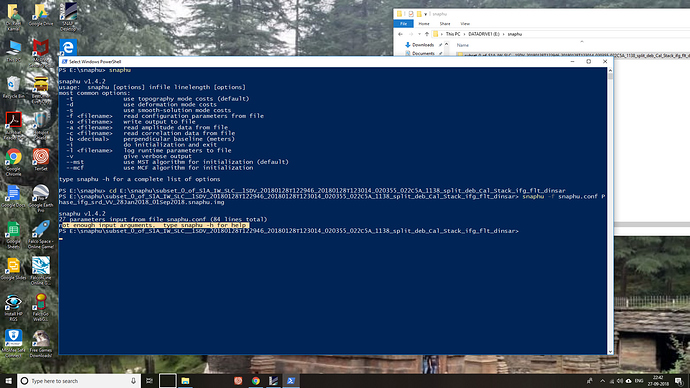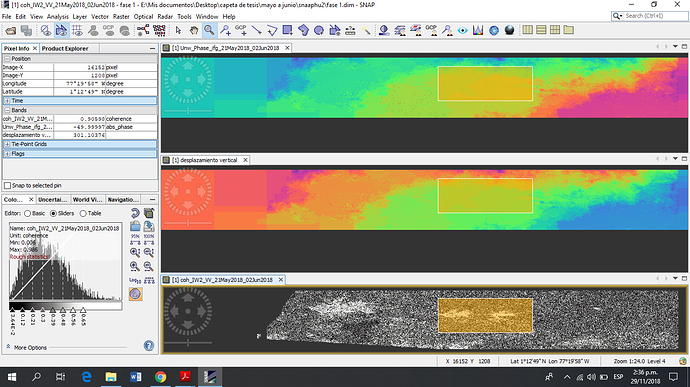where do you see extremes and what is the value range between blue and red?
The blue is 0.174m and the red is -0.211. It is these two regions I am referring to.
Is it just a matter of ‘localising’ in these areas?
you missed the number of lines at the end
See here: https://www.youtube.com/watch?v=sH4Uhsgmpak from 1:50
Could you please tell me the purpose behind removing the topographic phase?
The topographic phase is useful if you are generating a DEM but otherwise it should be removed so that it does not mask other signals of interest (deformation, coherence etc.).
answer in another post
for the future please avoid duplication of your questions
Hello
I have doubts about the process to convert the unwrapping phase to terrain displacement, could you please guide me?
please describe more specifically, what data you are using, how you preprocessed it and at which step you struggle.
Good afternoon,
My project is to determine the deformation of Galeras volcano (located in Colombia), at this time I followed the entire tutorial “Installation SNAPHU in Windows”, and I have the phases of the pairs of images to be treated.
and there are born my multiple doubts:
- the unwrapping phase has units of measurement? If the answer is yes, what is the unit of measurement?
- I have a formula to convert the unwrapped phase to displacement, it is as follows: (unwrapping phase * 56mm) / (- 4 * PI * cos (θ incidence)), however when applying it I obtain very large deformation value and taking into account account other data of the SGC the result values do not coincide and exceed too much, do I want to know if the formula is wrong?
- what is the correct way to interpret the final image; that is, in what units?
! [image | 690x387] (upload: //wbtep1boXN3iL7MjbtNMYJkPuXI.jpeg)
what happens is that the values of vertical displacement are of more than 10 cm and that value is very high, if it is compared with those of the SGC that monitors the Volcano in real time.
Using the formula is the traditional way but you can as well use the “phase to displacement” module.
You have to note three things:
- the displacement derived from the formula is a relative measure. It simply adds up the phase increase/decrease and converts it into metric units (if you enter the wavelength in mm you get the displacement in mm). You have to find a ‘zero displacement point’ in your area and calculate the remaining change from that. Explained here: Subsidence map in 3d view
- The displacement is not in vertical direction alone but along the line of sight (LOS) between each pixel and the sensor. So you have to consider the slant looking geometry of the SAR sensor.
- unwrapping works best if you have large connected areas of high coherence. The phase fringes are then added together to convert the circular measure to an absolute. But if, as in your case, high coherence is only available in small enclosed areas, the unrwapping/displacement values cannot be compared throughout the full image (e.g. from left to right) because the phase only gets randomly added up without being represented by the real phase information.
teniendo mi fase desenvuelta como se que lugares no has sufrido deformacion?
como sé que zonas no has sufrido deformación?
Dear pulido,
This is an English forum. Please ask your questions in English.
Then everyone can understand your questions
ok, sorry is the custom.
my question is how do I determine which zone has not suffered deformation? or on what basis do I choose that area? what is the procedure?
Hi.
Sr. I want to know. How can I descompose the deformation value?.
for differentiate the deformation horizontal and vertical
this is discussed here:
Hi, i want know, what is the range of error of the formula (Unw_Phase_ifg_date * .056) / (-4 * PI * cos(rad(incident_angle)?
the only variable which potentially includes errors is the unwrapped phase. If your interferogram is bad (low coherence, no fringes) the unwapping will result in weird patterns (or no patterns at all), and consequently, the formula won’t make it any better afterwards.
But those errors are corrected by the program, processing until the interferogram is obtained?

